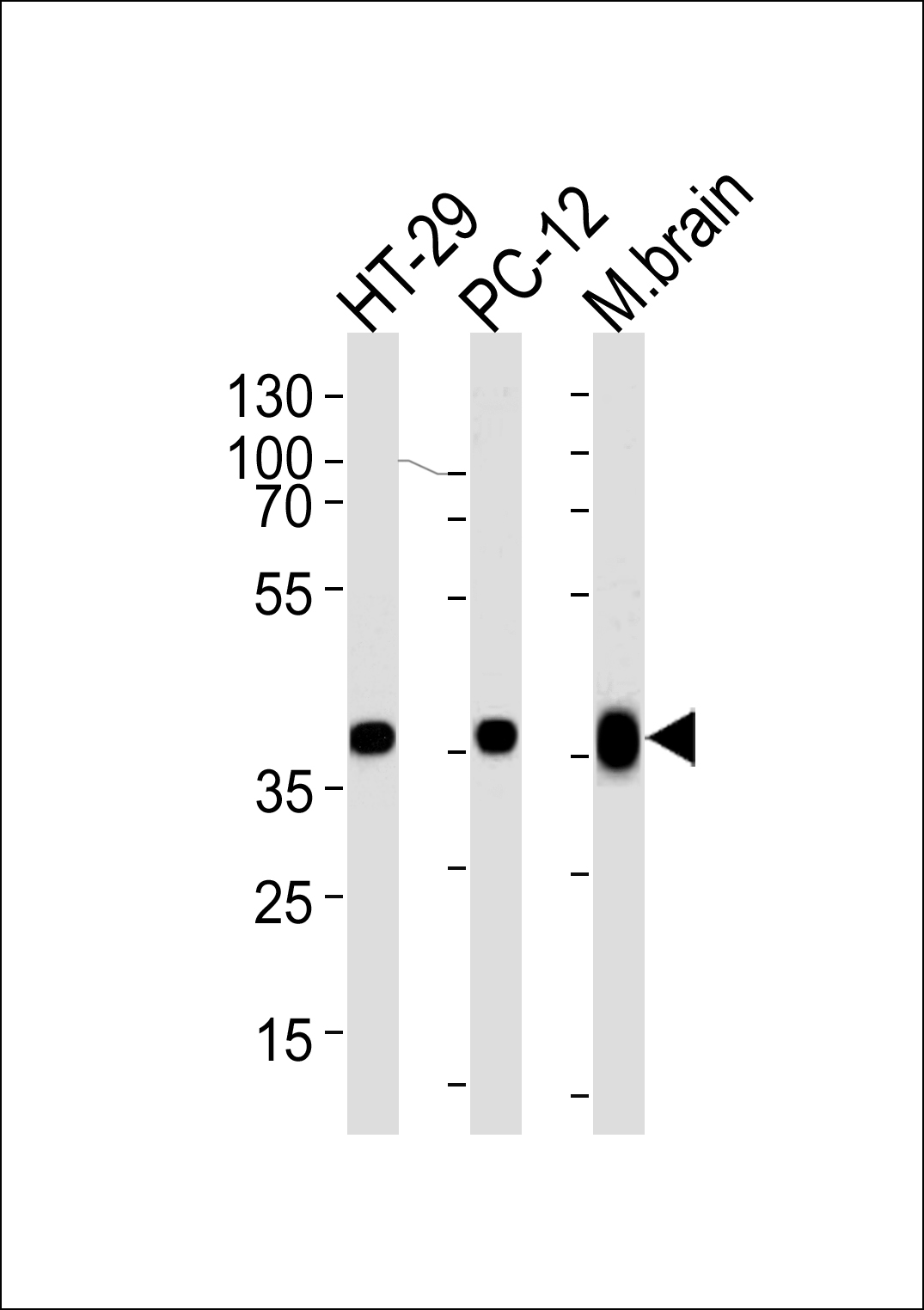PPP1CB Antibody (C-term)
Affinity Purified Rabbit Polyclonal Antibody (Pab)
- 产品详情
- 实验流程
- 背景知识
Application
| WB, E |
|---|---|
| Primary Accession | P62140 |
| Other Accession | Q6GQL2, P62142, P62143, P61292, P62141, P62207, Q3SWW9, NP_002700.1, NP_996759.1 |
| Reactivity | Human, Rat, Mouse |
| Predicted | Bovine, Chicken, Mouse, Pig, Rabbit, Rat, Xenopus |
| Host | Rabbit |
| Clonality | Polyclonal |
| Isotype | Rabbit IgG |
| Calculated MW | 37187 Da |
| Antigen Region | 298-327 aa |
| Gene ID | 5500 |
|---|---|
| Other Names | Serine/threonine-protein phosphatase PP1-beta catalytic subunit, PP-1B, PPP1CD, PPP1CB |
| Target/Specificity | This PPP1CB antibody is generated from rabbits immunized with a KLH conjugated synthetic peptide between 298-327 amino acids from the C-terminal region of human PPP1CB. |
| Dilution | WB~~1:1000 E~~Use at an assay dependent concentration. |
| Format | Purified polyclonal antibody supplied in PBS with 0.09% (W/V) sodium azide. This antibody is purified through a protein A column, followed by peptide affinity purification. |
| Storage | Maintain refrigerated at 2-8°C for up to 2 weeks. For long term storage store at -20°C in small aliquots to prevent freeze-thaw cycles. |
| Precautions | PPP1CB Antibody (C-term) is for research use only and not for use in diagnostic or therapeutic procedures. |
| Name | PPP1CB |
|---|---|
| Function | Protein phosphatase that associates with over 200 regulatory proteins to form highly specific holoenzymes which dephosphorylate hundreds of biological targets. Protein phosphatase (PP1) is essential for cell division, it participates in the regulation of glycogen metabolism, muscle contractility and protein synthesis. Involved in regulation of ionic conductances and long-term synaptic plasticity. Component of the PTW/PP1 phosphatase complex, which plays a role in the control of chromatin structure and cell cycle progression during the transition from mitosis into interphase. In balance with CSNK1D and CSNK1E, determines the circadian period length, through the regulation of the speed and rhythmicity of PER1 and PER2 phosphorylation. May dephosphorylate CSNK1D and CSNK1E. Dephosphorylates the 'Ser-418' residue of FOXP3 in regulatory T-cells (Treg) from patients with rheumatoid arthritis, thereby inactivating FOXP3 and rendering Treg cells functionally defective (PubMed:23396208). Core component of the SHOC2-MRAS-PP1c (SMP) holophosphatase complex that regulates the MAPK pathway activation (PubMed:35768504, PubMed:35831509, PubMed:36175670). The SMP complex specifically dephosphorylates the inhibitory phosphorylation at 'Ser-259' of RAF1 kinase, 'Ser-365' of BRAF kinase and 'Ser-214' of ARAF kinase, stimulating their kinase activities (PubMed:35768504, PubMed:35831509, PubMed:36175670). The SMP complex enhances the dephosphorylation activity and substrate specificity of PP1c (PubMed:35768504, PubMed:36175670). |
| Cellular Location | Cytoplasm. Nucleus. Nucleus, nucleoplasm. Nucleus, nucleolus. Note=Highly mobile in cells and can be relocalized through interaction with targeting subunits. In the presence of PPP1R8 relocalizes from the nucleus to nuclear speckles. |
For Research Use Only. Not For Use In Diagnostic Procedures.
Provided below are standard protocols that you may find useful for product applications.
BACKGROUND
The protein encoded by this gene is one of the three catalytic subunits of protein phosphatase 1 (PP1). PP1 is a serine/threonine specific protein phosphatase known to be involved in the regulation of a variety of cellular processes, such as cell division, glycogen metabolism, muscle contractility, protein synthesis, and HIV-1 viral transcription. Mouse studies suggest that PP1 functions as a suppressor of learning and memory. Two alternatively spliced transcript variants encoding distinct isoforms have been observed.
REFERENCES
Lee, J.H., et al. J. Biol. Chem. 285(32):24466-24476(2010)
Fujiki, R., et al. Nature 459(7245):455-459(2009)
Mavaddat, N., et al. Cancer Epidemiol. Biomarkers Prev. 18(1):255-259(2009)
Sueyoshi, T., et al. Mol. Pharmacol. 73(4):1113-1121(2008)
Rikova, K., et al. Cell 131(6):1190-1203(2007)
终于等到您。ABCEPTA(百远生物)抗体产品。
点击下方“我要评价 ”按钮提交您的反馈信息,您的反馈和评价是我们最宝贵的财富之一,
我们将在1-3个工作日内处理您的反馈信息。
如有疑问,联系:0512-88856768 tech-china@abcepta.com.























 癌症的基本特征包括细胞增殖、血管生成、迁移、凋亡逃避机制和细胞永生等。找到癌症发生过程中这些通路的关键标记物和对应的抗体用于检测至关重要。
癌症的基本特征包括细胞增殖、血管生成、迁移、凋亡逃避机制和细胞永生等。找到癌症发生过程中这些通路的关键标记物和对应的抗体用于检测至关重要。 为您推荐一个泛素化位点预测神器——泛素化分析工具,可以为您的蛋白的泛素化位点作出预测和评分。
为您推荐一个泛素化位点预测神器——泛素化分析工具,可以为您的蛋白的泛素化位点作出预测和评分。 细胞自噬受体图形绘图工具为你的蛋白的细胞受体结合位点作出预测和评分,识别结合到自噬通路中的蛋白是非常重要的,便于让我们理解自噬在正常生理、病理过程中的作用,如发育、细胞分化、神经退化性疾病、压力条件下、感染和癌症。
细胞自噬受体图形绘图工具为你的蛋白的细胞受体结合位点作出预测和评分,识别结合到自噬通路中的蛋白是非常重要的,便于让我们理解自噬在正常生理、病理过程中的作用,如发育、细胞分化、神经退化性疾病、压力条件下、感染和癌症。






